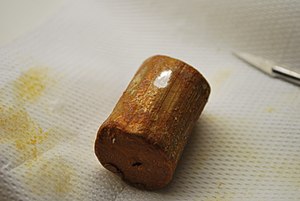Sodium superoxide

| |
| Names | |
|---|---|
| IUPAC name
sodium superoxide
| |
| Other names
sodium superoxide
sodium dioxide | |
| Identifiers | |
3D model (JSmol)
|
|
| ChemSpider | |
PubChem CID
|
|
| RTECS number |
|
| UNII | |
| UN number | 2547 |
| |
| |
| Properties | |
| NaO2 | |
| Molar mass | 54.9886 g/mol |
| Appearance | Yellow to orange crystalline solid |
| Density | 2.2 g/cm3 |
| Melting point | 551.7 °C (1,025.1 °F; 824.9 K) |
| Boiling point | Decomposes |
| Decomposes | |
| Basicity (pKb) | N/A |
| Structure | |
| cubic | |
| Thermochemistry | |
Heat capacity (C)
|
72.1 J/mol K |
Std molar
entropy (S⦵298) |
115.9 J/mol K |
Std enthalpy of
formation (ΔfH⦵298) |
-260.2 kJ/mol |
Gibbs free energy (ΔfG⦵)
|
-218.4 kJ/mol |
| Hazards | |
| GHS labelling: | |
 
| |
| Danger | |
| H271, H314 | |
| P210, P220, P260, P280, P303+P361+P353, P305+P351+P338 | |
| NFPA 704 (fire diamond) | <imagemap>
File:NFPA 704.svg|80px|alt=NFPA 704 four-colored diamond poly 150 150 300 300 150 450 0 300 Health 3: Short exposure could cause serious temporary or residual injury. E.g. chlorine gas poly 300 0 450 150 300 300 150 150 Flammability 0: Will not burn. E.g. water poly 450 150 600 300 450 450 300 300 Instability 1: Normally stable, but can become unstable at elevated temperatures and pressures. E.g. calcium poly 300 300 450 450 300 600 150 450 Special hazard OX: Oxidizer. E.g. potassium perchlorate desc none </imagemap> |
| Flash point | Non flammable |
| Related compounds | |
Other anions
|
sodium oxide sodium peroxide |
Other cations
|
Lithium superoxide Potassium superoxide Rubidium superoxide Caesium superoxide |
Except where otherwise noted, data are given for materials in their standard state (at 25 °C [77 °F], 100 kPa).
| |
Sodium superoxide is the inorganic compound with the formula NaO2.[1] This yellow-orange solid is a salt of the superoxide anion. It is an intermediate in the oxidation of sodium by oxygen.
Preparation
NaO2 is prepared by treating sodium peroxide with oxygen at high pressures:[2]
- Na2O2 + O2 → 2 NaO2
It can also be prepared by careful oxygenation of a solution of sodium in ammonia:
- Na(in NH3) + O2 → NaO2
It is also produced, along with sodium peroxide, when sodium is stored under inappropriate conditions (e.g. in dirty or partially halogenated solvents)[citation needed].
Properties
The product is paramagnetic, as expected for a salt of the O−
2 anion. It hydrolyses readily to give a mixture of sodium hydroxide, oxygen and hydrogen peroxide.[3] It crystallizes in the NaCl motif.
References
- ^ Hayyan, Maan; Hashim, Mohd Ali; AlNashef, Inas M. (2016-02-15). "Superoxide Ion: Generation and Chemical Implications". Chemical Reviews. 116 (5). American Chemical Society (ACS): 3029–3085. doi:10.1021/acs.chemrev.5b00407. ISSN 0009-2665. PMID 26875845.
- ^ Stephen E. Stephanou, Edgar J. Seyb Jr., Jacob Kleinberg "Sodium Superoxide" Inorganic Syntheses 1953; Vol. 4, 82-85.
- ^ Sasol Encyclopaedia of Science and Technology , G.C. Gerrans, P. Hartmann-Petersen , p.243 "sodium oxides" , google books link
- Articles without InChI source
- Articles without EBI source
- Articles without KEGG source
- Chembox image size set
- Short description with empty Wikidata description
- Articles with unsourced statements from July 2010
- Articles with invalid date parameter in template
- Superoxides
- Sodium compounds
- Photographic chemicals
- Oxidizing agents
- Inorganic compound stubs